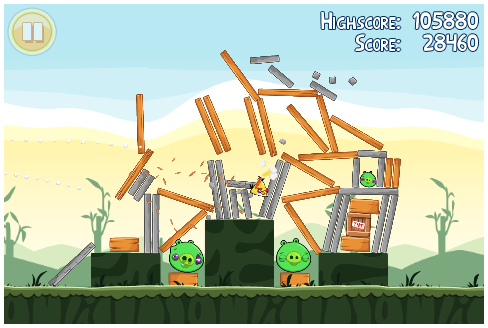How Angry Birds Became So Very Dear to My Heart
by Liz Colville

“Plump and ripe for roasting, Angry Birds is as addictive as any puzzler gets with light-hearted gameplay that flies with the best of the flock.”
— Pocketgamer
The logic of Angry Birds, currently the top paid game in the iPhone’s App Store, may appear endearing and amusing enough to write an essay about it because I discovered it while on a road trip from New York to California this past weekend. Like most modes of long-haul transportation, a car affords a great deal of clear-headedness and introspection. A daft game becomes an addiction, yes, because the time in the passenger seat is boring, but it also becomes a really adorable enterprise, a mirror in which to ponder one’s life, and possibly even observe a parable of Western civilization looming before you in the form of a deceptively simple, colorful game that for some reason has a million levels but only costs 99 cents.
The game starts off simply enough: you are a series of angry red birds — what are they angry about? I don’t know. What are you angry about? — that ricochet out of a slingshot onto anthropomorphic green blobs, an enemy that is, troublingly, cute. When you fail to adequately slam yourself into the blobs, they grin, sometimes through a gap-tooth smile and black eyes, if you have hurt them enough to cause these injuries but not enough to pop them off. The grins signal, “Haha, you fucked up, please try again.” There is also a giant red-mustachioed blob that appears later. When he is saved from death, he just closes his eyes in bliss, his smile hidden behind his mustache. The blobs look like a friend of mine combined with the cartoon version of the Gorillaz. I’m probably projecting my friend and Western civ upon the game because I just moved across the country and things are deep right now.
Events obviously get more complicated and more awesome as you pass more levels, and, following the arc of military invention, soon there are bomb-wielding birds and the attendant helmet-wearing green blobs. “Ooh, helmets,” one might say when one has reached the first helmet level. “How will I destroy the blobs now?” Pretty soon you realize that by tapping the screen while slinging a goose-like bird in the air — new kinds of birds with new powers appear as you progress through the game — an egg is released from the bird, but instead of landing on the ground in a yokey mess, the egg is really just a bomb that looks like an egg, and it can explode rock, wood and ice — the three materials that the green blobs use to protect themselves. Precision is key, and it was around this violent time in the game that I became addicted to it, because — violence. But also, precision has never been required of any other iPhone game I’ve played, and again, 99 cents. Plus, you never die, as in Mario Brothers or other staples of youth. You have unlimited chances to pass each level. You pay 99 cents for a game to have utmost faith in you. When you fail, you can just tell yourself, “There’s no reason to get angry. Just try again.” Sometimes this doesn’t work. Sometimes you get angry. It’s OK. That’s what the game is for. Ish.
There is an adorable irony at play in Angry Birds, and you’re awarded it once you make your way to Level 2 or so of the game. Essentially, there are two levels of make-believe at play. It is make-believe because it is a game. But it’s also make-believe because the blobs live in a simple world where the only raw materials available to them are ice, rocks and wood (and sometimes rubber duckies and beach balls and other odd, child-like things). Why? I don’t know, but it’s lovely. In a game where the creators could conceivably illustrate anything they wanted, real or imagined, they instead use only three materials to make elaborate things for the blobs to live in. A ship is made out of pieces of wood piled together in the shape of a ship; cannon balls are made of rock (and they don’t actually work as cannonballs, poor blobs, they’re just for show); the water that the ship is in is made of ice. I am in love with whoever is responsible for this.
I’m not sure what role this game will have in my life now that the road trip is over. Subway trips? Light bedtime hand-eye coordination? Lunch break? Waiting for tea to steep? Waiting to cross a street? Walking across the street? Running? But just as I never got down on myself for never being able to finish the math portion of the SAT, and really, I never did finish it, I do not feel defeated for having to play a level 37 times before I finally pass it. There are so many satisfying moments on the way to winning or, more likely, losing this game, the best of which might simply be watching “yourself” crash into one of the blob’s little houses or boats or cars and watching it slowly, slowly fall to the ground like a scene from a bad action movie, and hopefully take the blobs, those darlings, with it.